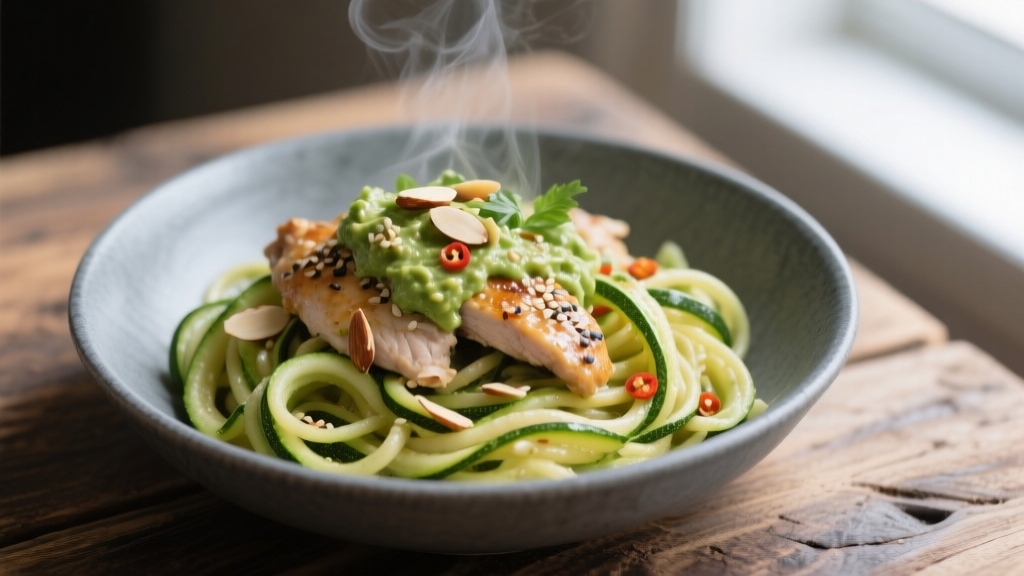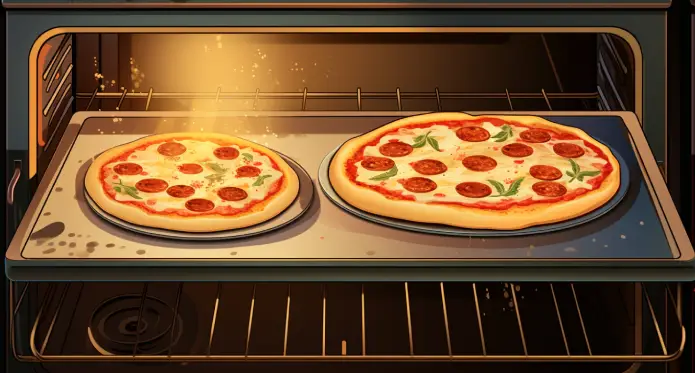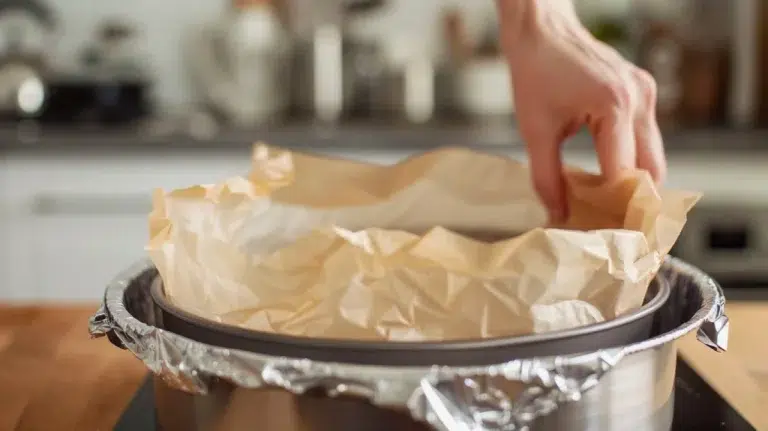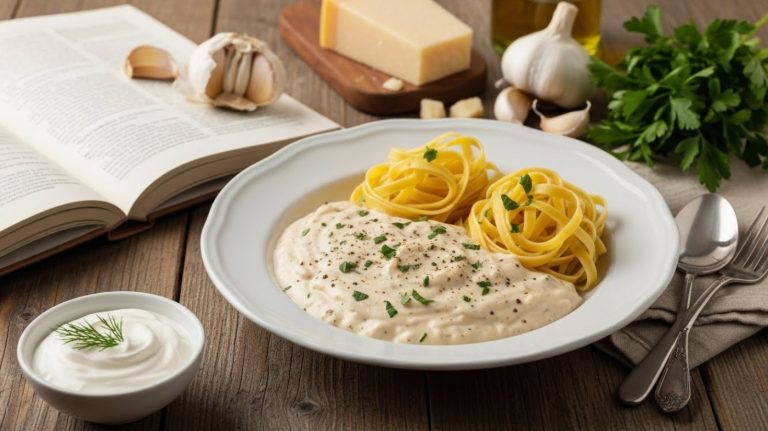High Protein Low Carb Pasta Recipes: Muscle-Friendly Dishes
You can enjoy high-protein, low-carb pasta by choosing legume-based or egg-enriched varieties that offer up to 17 grams of protein and minimal carbs. Cooking in boiling salted water and tasting early guarantees perfect al dente texture.
Pair with protein-rich sauces like Greek yogurt parmesan or lean meats for extra flavor and nutrition. These dishes enhance satiety and blood sugar control while adding fiber and essential nutrients. Explore a range of recipes and tips to optimize your meals.
Key Takeaways
- Use legume-based or plant-based pasta varieties for higher protein and lower carb content in recipes.
- Combine pasta with protein-rich sauces like cottage cheese or Greek yogurt-based Alfredo for added protein.
- Incorporate lean meats, tofu, or tuna to boost protein while keeping carbohydrate levels low.
- Experiment with flavorful seasonings such as garlic, oregano, and nutritional yeast to enhance taste without carbs.
- Opt for one-pan or simple recipes that balance protein, fiber, and low-carb ingredients for easy meal prep.
Quick High Protein Low Carb Pasta Recipes to Try Tonight
| Recipe | Ingredients / Tools | Steps / Actions | Notes / Tips |
|---|---|---|---|
| Chicken Alfredo with Chickpea Pasta | Chickpea pasta, Greek yogurt, chicken breast, garlic powder, Parmesan, olive oil | Boil pasta al dente. Sauté chicken with garlic. Mix Greek yogurt and Parmesan for sauce. Combine pasta and chicken. | Toss with olive oil to prevent sticking |
| Lentil Bolognese with Whole Wheat Pasta | Whole wheat pasta, red lentils, tomato sauce, garlic, onion, oregano | Cook pasta al dente. Sauté garlic and onion, add lentils and tomato sauce, simmer. Mix with pasta. | Use fresh herbs for extra flavor |
| One-Pan Tuna Pasta | Chickpea or legume pasta, canned tuna, capers, sun-dried tomatoes, olive oil | Boil pasta. In a pan, heat tuna, capers, and tomatoes. Mix with cooked pasta. | Perfect for quick weeknight meals |
| Marry Me Chicken Pasta | Chickpea shells, chicken breast, cottage cheese, garlic, oregano, black pepper | Cook pasta al dente. Sauté seasoned chicken. Blend cottage cheese with spices, combine with pasta and chicken. | Creamy and protein-rich without excess carbs |
| Tofu Spinach Pasta | Legume pasta, tofu, fresh spinach, garlic, olive oil, nutritional yeast | Boil pasta. Sauté tofu and spinach with garlic. Mix with pasta and sprinkle nutritional yeast. | Great vegetarian option; boost protein with hemp seeds |
Best High Protein Low Carb Pasta Varieties
When choosing the best high protein, low carb pasta varieties, you’ll find options across several categories that balance nutrition and taste effectively.
Plant-based blends like Pete’s Pasta offer 17 g protein and 7 g carbs per serving, mimicking traditional pasta texture. These products often cater to various dietary needs such as keto, paleo, and gluten-free, providing versatile alternatives. Considering material durability in pasta production can also affect texture and cooking performance.
Pete’s Pasta delivers 17 g protein and 7 g carbs per serving with a traditional pasta feel.
Legume-based pastas, including edamame and black bean varieties, boost protein and fiber, though their distinct flavors may not suit everyone.
Egg-containing pastas, such as Al Dente Carba-Nada, provide quick cooking and a familiar taste, with 16 g protein and moderate carbs.
High-fiber options like ThinSlim Foods’ Impastable Pasta combine mixed flours and isolates, enhancing digestive health despite a chewier texture.
Specialty products with pea protein and fibers deliver low net carbs ideal for keto and diabetes diets. Your choice depends on dietary needs and flavor preferences.
Cooking Techniques for Perfect Texture
Although selecting the right pasta is essential, mastering cooking techniques profoundly impacts the final texture. To achieve a perfect bite, start by boiling water vigorously in a large pot, seasoning it generously with salt.
Use a large pan to ensure sufficient room for even cooking and to help the pasta cook uniformly. For kitchens with limited space, utilizing equipment with a smaller footprint can optimize workflow.
Add pasta only once the water is rolling, stirring gently to prevent sticking. Monitor cooking closely, tasting a few minutes before the package time to hit al dente—the ideal firmness.
Once cooked, drain promptly without rinsing, then toss with a bit of olive oil or butter to maintain texture and prevent clumping.
Key tips for perfect texture:
- Use ample salted boiling water in a large pot
- Stir pasta immediately and periodically during cooking
- Taste early and often for al dente doneness
- Drain quickly to stop cooking
- Toss with fat to avoid sticking and enhance mouthfeel
Flavorful Sauce Pairings and Toppings
Since sauces and toppings define the flavor profile of your pasta, choosing high-protein, low-carb options can elevate both taste and nutrition.
Sauces and toppings shape your pasta’s flavor—opt for high-protein, low-carb choices to boost taste and nutrition.
You can blend cottage cheese into tomato sauces for a creamy texture and 16g protein per serving or add Greek yogurt with Parmesan for about 35g protein. This creamy, high-protein pasta sauce often includes parmesan, oregano, garlic powder, black pepper, and salt to enhance flavor. Unlike pizza sauce, pasta sauces are typically slow-simmered to develop a richer flavor.
Meat sauces with lean chicken or grass-fed beef bring hearty flavor and extra protein. Plant-based sauces with red lentils and nutritional yeast offer vegan-friendly protein and umami. Top with grilled chicken or hemp seeds for added protein and omega fats.
Creative High Protein Low Carb Pasta Recipes
Creative high-protein, low-carb pasta recipes combine nutrient-dense ingredients like chickpea or lentil-based pasta with lean poultry, seafood, or plant proteins to maximize muscle-building benefits without excess carbohydrates.
You can create balanced meals that support your goals by choosing options with high protein and fiber but low net carbs.
Consider these ideas:
- Chicken Alfredo with chickpea pasta and Greek yogurt offers ~35g protein per serving.
- Lentil Bolognese with whole wheat pasta provides a plant-based 22g protein option.
- One-pan tuna pasta blends protein-rich tuna, capers, and sun-dried tomatoes efficiently.
- Marry Me Chicken Pasta pairs seasoned chicken with cottage cheese sauce and chickpea shells.
- Tofu spinach pasta enriches protein content for vegetarian, low-carb meals.
These recipes emphasize lean proteins and nutrient-rich bases for optimized muscle support. Using electric smokers can add unique smoky flavors to proteins like chicken or fish, enhancing taste without adding carbs.
Nutritional Benefits and Dietary Tips
When you choose high-protein, low-carb pasta, you’re not just cutting calories. You’re enhancing satiety and supporting weight management. This pasta’s higher protein and fiber content prolong fullness, reduce cravings, and help regulate blood sugar.
Many varieties are made from legumes, which adds additional fiber and micronutrients to your diet. Selecting foods with adjustable thickness can also improve meal customization and enjoyment.
It also provides essential amino acids for muscle repair and offers beneficial micronutrients like iron and magnesium. To optimize benefits, balance your meals with varied protein sources and practice portion control.
Frequently Asked Questions
Where Can I Buy High Protein Low Carb Pasta Locally?
You can buy high protein, low carb pasta locally at major grocery stores like Ralphs, which stock brands such as Banza and Barilla Protein+.
Specialty health food stores often carry keto-friendly options like ThinSlim Foods and Carbe Diem!
Ethnic markets may offer legume-based pastas or shirataki noodles.
Many stores also support online ordering with local pickup, letting you check availability and reviews before buying.
This ensures you get the best product for your diet.
How Should High Protein Pasta Be Stored After Opening?
After opening, store your dry high protein pasta in an airtight container or resealable bag, keeping it in a cool, dry, moisture-free place like a pantry.
Avoid refrigeration to prevent moisture absorption.
If you’ve cooked the pasta, refrigerate it in an airtight container, tossing it with a bit of oil to prevent clumping.
Consume cooked pasta within 2 to 3 days for safety and ideal quality.
Can These Pastas Be Used in Cold Pasta Salads?
Yes, you can definitely use these pastas in cold salads—they typically offer 25-30 grams of protein and just 3-5 grams of net carbs per serving. Their firm texture holds up well after cooling, preventing mushiness.
Just cook them al dente, drain thoroughly, and cool properly.
Pair them with fresh veggies and robust dressings to balance flavors. This makes for a nutritious, satisfying low-carb salad perfect for meal prep or light meals.
Are There Any Common Allergens in These High Protein Pastas?
Yes, you should watch for common allergens in these pastas. Many contain wheat derivatives, which can trigger wheat or gluten allergies.
Eggs often appear in fresh or specialty pastas, posing risks if you’re allergic.
Dairy proteins might be present in enriched pastas or sauces.
Additionally, tree nuts, soy, and lupine flour are potential allergens in some recipes or toppings.
Always check labels carefully to avoid hidden allergens.
How Do These Pastas Compare in Price to Regular Pasta?
Think of regular pasta as the reliable sedan—affordable and accessible—while high protein pastas are the luxury sports cars, costing more due to premium features.
You’ll pay roughly $4 to $6 for protein pasta, compared to $1 to $3 for regular varieties.
Specialty brands can spike prices even higher, but their added protein and low-carb benefits might justify the investment if you’re targeting specific nutritional goals.
Elevate Your Pasta Nights with High Protein Low Carb Options
Now that you know the best high protein low carb pasta varieties and how to cook them perfectly, why settle for boring meals? Pairing the right sauces and toppings not only boosts flavor but also enhances nutrition.
These recipes support your dietary goals without sacrificing taste or texture. By choosing wisely, you’re fueling your body efficiently and enjoying every bite. Ready to transform your pasta nights with healthy, satisfying options?







